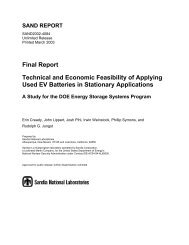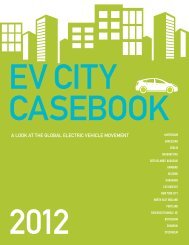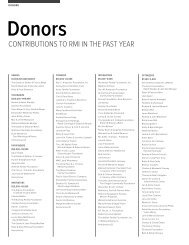Fleet Electrification Roadmap
Fleet Electrification Roadmap
Fleet Electrification Roadmap
- No tags were found...
You also want an ePaper? Increase the reach of your titles
YUMPU automatically turns print PDFs into web optimized ePapers that Google loves.
78 part two: fleet challenges fleet challengesfleet electrification roadmap 79Technology CostsElectric drive technology—HEV, PHEV, and EV—willlikely carry a significant upfront cost premium overinternal combustion engine vehicles across all vehiclesizes. While fleet operators may be willing to evaluatethe costs and savings of operating electric drive vehiclesover the entire life of the asset, it is nonetheless importantto understand the key drivers of technology costs.If targeted to the right fleet applications, the cost premiumfor electric drive vehicles can be quickly recoveredthrough operational savings. Alternative business modelsmay also play a role. In general, batteries are the key costdriver for electric drive technologies, though powertraincomponents and infrastructure are important as well.BatteriesBattery costs vary by chemistry and by the type of drivetrainfor which they are optimized. Lithium-ion batteriesoptimized for light-duty HEV applications currentlycarry an average cost of $1,500 per kWh. 1 The cost isslightly higher for HEV batteries optimized for heavierapplications. These batteries are designed to providesignificant power support to the internal combustionengine during certain driving functions like acceleration.Because HEV batteries tend to be smaller relative to thebatteries needed by PHEVs and EVs, they carry a lowercost in absolute terms.Lithium-ion batteries for PHEVs and EVs currentlyaverage $600 per kWh. These batteries must be optimizedto carry a large amount of energy to power autonomousdriving during charge-depleting mode. The amount ofenergy required for PHEV applications is somewhat lessthan for EVs, so these batteries must also balance powerand energy. The result is that PHEV batteries can be moreexpensive than EV batteries on a per kWh basis. Both EVand PHEV batteries represent large shares of total vehicle1 EC, PRTM interviews.FIGURE 2ABattery Cost by Size and Type ($/kWh)cost. For example, a 16 kWh PHEV battery can equate to29 percent of final vehicle cost, while a 24 kWh EV batterycan equate to as much as 33 percent of final vehicle cost. 2In heavier applications, this share can increase as the costof battery management components also increases.Battery LifeBattery life can be measured in terms of calendar life,but cycle life is the most commonly cited metric. Cyclingrefers to the process of discharging and recharging batteries.The cycling of lithium-ion batteries is most detrimentalto their health when they are deeply discharged; that is,when their energy is so completely depleted the remainingstate of charge of the battery is very low. Alternatively,battery health is also severely damaged when the batteryis held at a very high state of charge for long periods oftime. At a practical level, the deleterious effects of deepcycling and overcharging result in a rapid reduction ofusable battery capacity. In an electric vehicle, this wouldeffectively shorten the range of the car and ultimately cutshort the calendar life of the battery. The first generationof large-format lithium-ion batteries is targeting a cyclelife of 1,500 to 3,000 cycles. 3 At the most basic level, a batterywith a 3,000 cycle life would last the average driverabout eight years if it were fully cycled once each day.A more tangible metric for many drivers may be themileage life of their battery. Battery mileage life will varydepending on the cycle history of the battery, the way thevehicle is driven, and the drivetrain configuration. HEVbatteries, for example, will have mileage lives as high as250,000 miles or more, because they are cycled extremelynarrowly. Alternatively, EV batteries are targeting 150,000miles over the life of the battery.2 PRTM analysis.3 John Axsen et al, Batteries for Plug-in Hybrid Electric Vehicles, Goals andState of the Technology circa 2008, at 7, (2008).BATTERY TYPE BATTERY SIZE 2010 2015 2020Li-Ion HEV 8 kWh $2,000 $1,625 $1,250Li-Ion EV 25 kWh $600 $488 $325Cost DriversTo date, a lack of scale has been the most significant factorbehind high battery costs. As much as 70 percent of thecost of lithium-ion cells is related to raw materials, andcells account for 80 percent of pack costs. 4 Small improvementsin cell production costs, while difficult, can thereforehave a significant impact on pack costs. According toresearch conducted by the Department of Energy, a plantthat is capacitized to produce 10,000 battery packs peryear as opposed to 100,000 will have battery costs that are4 PRTM analysis.Nameplate or Usable Energy?approximately 60 percent to 80 percent higher. 5 In a May2009 Department of Energy review, research was presentedthat indicated using current materials and currentprocessing technology, scaling up to 500,000 units peryear would drive the cost of PHEV packs down to $363per kWh. 6 Additionally, the research indicated other possiblemanufacturing developments that could push thatprice down farther.5 Paul A. Nelson, Danilo J. Santini, and James Barnes, “FactorsDetermining the Manufacturing Costs of Lithium-Ion Batteries forPHEVs,” (May 2009).6 Barnett, Brian, et. al., “PHEV Battery Cost Assessment,” Tiax LLC,(May19, 2009), Presented at the May 2009 DOE Merit Review.When describing the cost and performance metrics of today’s large-format automotive batteries, it is important to distinguishbetween ‘nameplate’ and “usable energy.’ Nameplate figures assign a value—for example, cost or capacity—to the entire battery packand divide that figure by the maximum number of kilowatt hours of battery capacity. The nameplate cost of a battery reflects thetotal cost of the battery divided by the total number of kilowatt hours (kWh) of capacity. Therefore, a pack that costs $12,000 and has24 kWh of capacity would have nameplate battery costs of $500 per kWh.However, in practice the nameplate energy capacity of today’s batteries is not typically fully utilized. Most battery suppliers arebuilding in a reserve margin at the low- and high-end of the battery’s state of charge to avoid overheating and excessive discharge.In some cases, this reserve portion can represent up to 50 percent of a battery's nameplate capacity. In other words, a 24 kWhbattery with a 50 percent state of charge reserve margin only has 12kWh of usable energy. In this case, the $12,000 battery wouldhave usable energy costs of $1,000 per kWh.In general, nameplate capacity is the more commonly used metric by industry. Therefore, whenever battery costs are quoted in thisreport, figures reference nameplate capacity.FIGURE 2BBattery Charge for Assorted Vehicle Types100%806040200UNCHARGEABLE CAPACITYEVPHEVHEVINSUFFICIENT CHARGEDISTANCE TRAVELEDUSABLE ENERGYNAMEPLATE CAPACITY
















